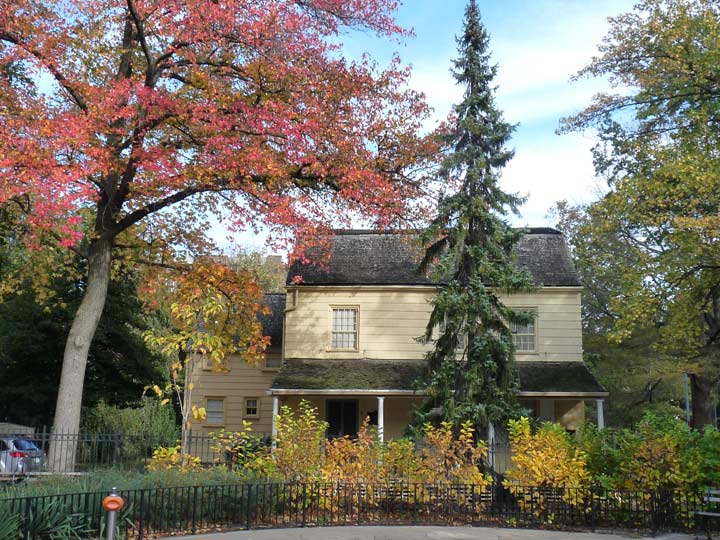
Amazingly, though Flushing can claim two buildings from the 17th century (Manhattan has none), 18th Century buildings are few and far between!
The Kingsland Homestead has been located in three sites since its construction in about 1790. In the 1920s it was moved from Roosevelt Avenue (Amity Street) at 154th Street to make way for an eastern extension of the Flushing subway that was never built; until 1968 it was located at the southeast corner of Roosevelt Avenue and 155th Street, where it was beginning to become rundown. The Queens Historical Society had it moved to its present location in Bowne Park, and the Society is housed in the homestead now.
Quaker Joseph Doughty constructed this building at about 1785-1790. It is named for his son-in-law, sea captain Joseph King, who bought it in 1802. It was later occupied by the Murray family, who gave their name to Murray Hill and Murray Street in east Flushing, well into the 20th Century. The interior of the homestead has been preserved pretty much as it was in the 19th century, and a public exhibit by the Queens Historical Society occupies much of the first floor that includes a representation of the Flushing Remonstrance, a 17th-Century treatise in which the citizens of Flushing pleaded with the Dutch government for religious freedom.
Check out the ForgottenBook, take a look at the gift shop, and as always, “comment…as you see fit.”
11/29/17

4 comments
Everytime a historic house is moved, I believe, it loses its historicity. It takes on a melancholic “loser” aura. Kingsland, Latimer, and even Hamilton Grange. Better than demolishing it, but not the same anymore. Just imagine schlepping the Bowne House and the Quaker Meeting house all over the place? They wouldn’t be the same anymore. No?
Fair enough, but if the alternative is demolition, relocation is a grand idea.
We rarely see houses moved any more, but it was much more common in the 1800’s than you might think. In the days before the industrial revolution, everything was made by hand. That included nails, finished woodwork, windows, etc. The basic frame of a house required felling of trees, trimming logs to timbers, etc. That was all very expensive. If you moved a house, you didn’t have to deal with plumbing or electrical concerns. You didn’t have to deal with overhead telephone or electrical or cable lines, and you didn’t have to worry about underground water, or gas or sewer lines being crushed. I doubt you needed a permit to do it, and there was so little traffic in these rural areas that you really didn’t burden anyone if you pulled a house down a road by oxen for a few days or so. You probably provided entertainment for your neighbors.
It was often cheaper and faster to buy and move a house than to design and build one.
A correction: The Kingsland Homestead is not now and never has been in Bowne Park.
In 1968 it was moved to Weeping Beech Park. It is now in a location very close to the Bowne House (which may have caused the error in your write-up.)
Cordially,
Joseph Brostek
Queens Historical Society Trustee
8/1/2018
I and my family lived in the Kingsland Mansion for many years in the 40s up to the mid 50s. The date it was built was numbered near the front door was 1774. There was a separate building attached that was not part of the original house where our
kitchen was that did not get moved to Weeping Beech park.
John Dixon
jhndxn@gmail.com